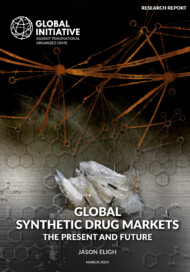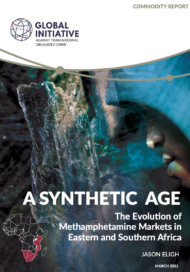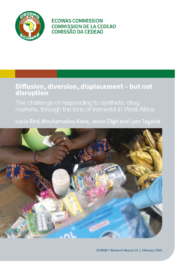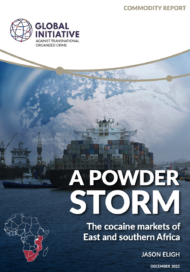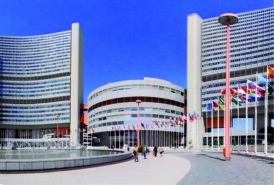Event Details
Where
Hybrid event
Posted on 22 Mar 2024
In recent years, the global landscape of illicit synthetic drug markets has undergone profound transformations, driven by a complex interplay of factors ranging from decentralized production models and deepening geopolitical schisms to open-source databases and other technological advancements. From the proliferation of dark web marketplaces to the emergence of new and novel psychoactive substances (NPS), these trends have generated significant and sometimes contradictory challenges to law enforcement agencies, public health systems and policymakers worldwide.
Rapid, unregulated expansion of the global pharmaceutical and chemical sectors has been a fundamental driver behind what has become, over the last 10 years, but particularly in the last two years, a global explosion in illicit synthetic drug production, trafficking and use. A mass proliferation of chemists and firms producing and vending synthetic substances and their many precursors has helped propel an unprecedented propensity for licit industrial production channels and supply chains being diverted into illicit economic activity. One consequence of all this is the realization that synthetic drugs have become the future of drug trafficking.
One of the most notable trends in illicit synthetic drug markets has been the rapid expansion of online platforms, particularly on the dark web. These anonymous marketplaces provide a convenient and relatively secure environment for the sale and distribution of illicit substances, allowing vendors and buyers to operate with a degree of anonymity. Cryptocurrencies, some boasting of their untraceable digital footprint, have facilitated transactions, enabling actors to evade basic anti-money laundering requirements and law enforcement efforts. Moreover, the globalization of supply chains has enabled the widespread dissemination of synthetic drugs across borders.
Production hubs in countries with lax regulations and enforcement mechanisms serve as primary sources of supply for a diverse array of substances to markets around the world. The decentralization of production and distribution networks complicates efforts to disrupt these illicit activities.
The proliferation of NPS is a major concern. These synthetic compounds are often chemically modified versions of existing drugs, developed to mimic their effects while evading legal restrictions because of their chemical composition. Through its Early Warning Advisory on NPS, and in partnership with voluntary reporting by member states, the United Nations Office on Drugs and Crime (UNODC) has identified over 1 200 NPS from 141 different countries. The rapid pace of innovation in this domain challenges regulatory frameworks, as authorities struggle to keep pace with the emergence of these new synthetic substances, their potential health risks and their potential contribution to wider illicit drug market dynamics.
The escalation in the use of synthetic opioids, such as fentanyl and its analogues in North America, and tramadol in Africa, is a particularly alarming trend within illicit drug markets. These substances, vital to public health institutions for pain relief and palliative care purposes, but too often also produced clandestinely in makeshift laboratories, have been responsible for a significant increase in drug-related morbidity and mortality worldwide. Their potency and availability pose unprecedented challenges to public health systems and law enforcement agencies.
The diversion of precursor and pre-precursor chemicals from legitimate sources and supply chains has been a fundamental driver of the production of synthetic drugs on an industrial scale – and the harm that accompanies it. This diversion, either directly from the chemical and pharmaceutical enterprises that manufacture these substances or through acquisitions from compromised organizations that source supplies ostensibly on behalf of legitimate industrial end users, demonstrates the ineffectiveness of the current voluntary reporting and regulatory schemes that are in place across such a vast and complex industrial sector.
The intersection of synthetic drug markets with other illicit activities further complicates efforts to address these challenges effectively. Organized criminal networks leverage the profits generated from synthetic drug production, trafficking and distribution to fund their criminal operations. This contributes to perpetuating cycles of violence and instability that are affecting an ever-greater proportion of countries around the world, and occurs alongside the exploitation of highly interconnected financial hubs, like Singapore, Panama and Dubai.
In response to these evolving trends, governments and international organizations have sought to adopt a multifaceted approach, combining law enforcement efforts with public health initiatives. Some efforts have achieved positive results, particularly those that arise from public health-based objectives. However, the gravity of the crisis and, in particular, a recognition of the limits of our knowledge and capacity to understand and respond to what is happening in these markets around us, are inescapable. Enhanced international surveillance, cooperation and information sharing will become increasingly crucial in addressing the transnational nature of synthetic drug markets and their trade.
Drug suppliers have adapted to shifts in the illicit drug landscape. As a consequence, these markets reflect a complex and dynamic global economy characterized by advances in technological innovation, the incessant exploitation of vulnerabilities that arise from a steadily globalizing transport and communications infrastructure, and the complicity of corrupted individuals and groups who operate throughout the global economy, without whom the illicit trafficking in synthetics (and other illegal commodities, for that matter) would not exist.
